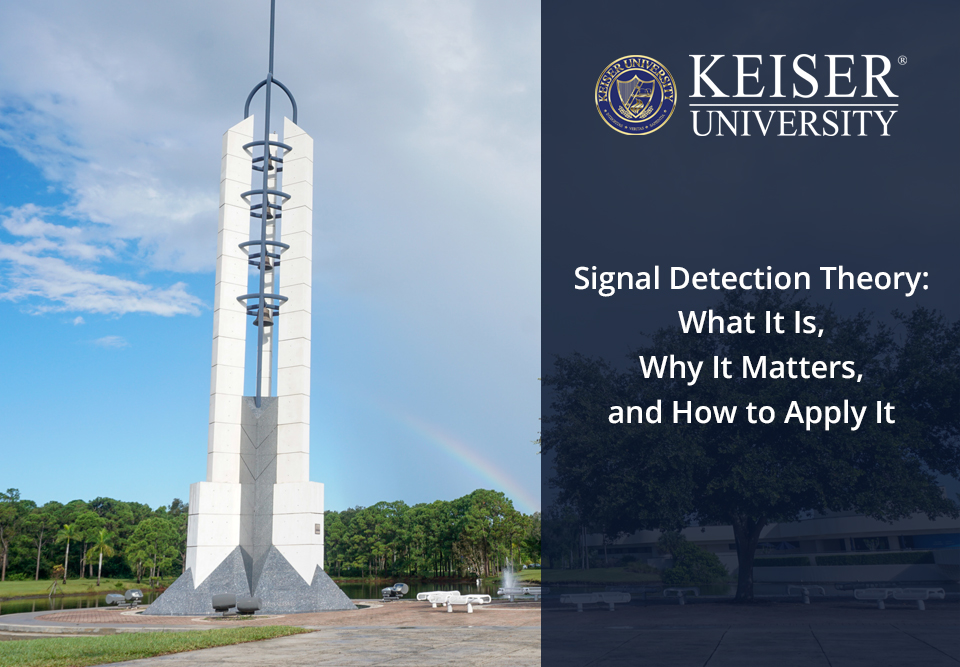Also commonly referred to as SDT for short, signal detection theory is a psychological concept that is applicable across a wide range of topics. Not only has it been heavily present in memory research dating all the way back to the 1970s, but it’s also present in work with individuals with ADHD, accuracy in radiology diagnostics, and more.
But as a theory and a technique, where did SDT come from? How has it evolved throughout its history? How has it changed the ways in which we think about certain psychological concepts and ideas? The answers to questions like these require you to keep a few key things in mind.
What Is Signal Detection Theory?
At its core, signal detection theory involves the measurement of the difference between two distinct patterns. The first is called the “stimulus” when you’re talking about some type of living organism or the “signal” when you’re talking about a machine. The second pattern involves the random noise that distracts either a person or a machine’s ability to collect and process information.
In other words, it looks at how easy or difficult it is for someone to process information and respond to it when they’re also being exposed to a lot of background noise or other needless distractions.
In general, humans notice things based on how strong the stimulus is and how much attention they’re paying. SDT dives deep into this concept and gives professionals a lot of actionable insights to work with in several different contexts.
What Is Signal Detection Theory in Psychology?
To put it as simply as possible, in psychology, signal detection theory relates to the idea that the intensity of the stimuli and the psychological and physical state of the person contribute to whether or not the person is able to detect the stimuli.
Studies on Decision Making
A number of studies have been done on SDT within the context of decision-making over the years. One of the more recent of them was published online by a team of researchers in 2018. It looked at the referral decision-making process of general practitioners in cases where a patient could potentially have lung cancer. Not only did it help the researchers better understand how certain stimuli impacted the referrals that these GPs were giving patients with possible lung cancer related to their one-year prognosis, but it also let them explore how characteristics like the gender and experience of those GPs impacted their ability to make accurate decisions.
Signal Detection Theory Applications
Overall, SDT is widely applicable, both within the context of humans and animals. Whether you’re conducting research into memory, the characteristics of certain stimuli, or how reinforcement occurs, you’re likely to encounter signal detection theory at some point.
Sensitivity or Discriminability
One of the major applications of SDT has to do with the general concepts of sensitivity or discriminability. Professionals use SDT to observe how difficult or easy it is for people to detect the presence of a specific type of stimulus when other background events are present.
If you were assessing someone’s memory, for example, you might show them a series of words on a piece of paper. In theory, having that person remember five words after a pre-determined period of time would be far easier than having them remember 30. Likewise, they would probably have an easier time recalling those words in total silence than if you were also playing music.
Even something as straightforward as giving Person 1 a longer amount of time to remember the words when compared to Person 2 can impact sensitivity or discriminability for both individuals.
Discovering Bias in Responses
Another common application of SDT has to do with determining bias in responses. In other words, what makes one specific response more probable for a given person? Someone may be more likely to respond one way if a stimulus is present and another way if it is not.
If you were conducting the same memory recall test as outlined above and people got penalties whenever they “missed” or couldn’t remember certain words, that would be a stimulus that would absolutely influence bias.
Compressed Sensing: Relation to Signal Detection Theory
One concept that isn’t quite the same thing as SDT but that is closely related is called compressed sensing. Here, you’re trying to recall “high dimensional but low complexity entities with only a few measurements.” (Wikipedia)
This is a technique that is commonly used in the medical field, for example. Essentially, what you’re talking about is compression – the same way you might compress a computer file to make it easier to store and send to someone else. Think about how complicated your average medical image, like an ultrasound, can be. Using the principles of signal detection theory as they relate to technology, those same medical images can be “compressed” with lower sampling rates.
This makes it not only easier and faster to transmit them from one location to another, but they also require less space to store, too. Most importantly, they can be interpreted accurately, quickly, and easily – which is of paramount importance in the healthcare setting.
Modern Utilization Through Technology
As previously mentioned, signal detection theory isn’t just present in psychology within the context of humans and animals. It also matters a great deal in the worlds of technology and electronics.
Think back to the inception of SDT and its origins in radar detection during World War II. Even though the technology itself has advanced and grown more sophisticated in the decades since, signal detection theory is still being used in the same basic way. What you’re trying to do is learn how to recover certain signals from irrelevant and often unpredictable “noise” that might be present in certain instrumentation.
As an example of this, think back to the days when people would listen to the radio in their car (as opposed to satellite radio or even just internet-based content like podcasts, as many do now). Most of us over a certain age have the experience of adjusting the dial, only to land “in-between” two stations. You’re essentially picking up two signals at once – the one you want and another irrelevant one, which is distracting and acting as unnecessary noise. In the context of electronics and technology, signal detection theory explains why something like this happens and what occurs when it does.
In a broader sense, SDT becomes a key component in something like meteorology, for example. Professionals use sophisticated equipment to collect information about weather patterns, quickly identifying what is actionable information that they can use to interpret the weather and what is just random noise that might be interfering with their readings.
History of Signal Detection Theory
Signal detection theory dates to the early 1940s, although it wasn’t called that at the time. It has also evolved tremendously over the years, both in concept and in application.
The Start of Signal Detection
Gustav Fechner
The beginning of what we now call signal detection theory (and experimental psychology in general) began with a man named Gustav Fechner. He was doing research into the mental judgment of humans to explain and understand why humans discriminate against some ideas and responses versus others.
World War II
In the 1940s, researchers were using what would become signal detection theory to better understand how radar technology worked. If you’re using radar to try to detect enemy aircraft before they have a chance to get into the optimal position to shoot or bomb you, for example, it stands to reason that you need that system to be as accurate as possible. But while early radar technology could easily identify a signal that was coming from something like a plane, it would naturally pick up additional “noise” as well. Signal detection theory helped people understand why this was the case and what to do about it so that they could make more accurate radar systems moving forward.
First Applications of the Theory
Based on the findings that were coming out of World War II, the value of signal detection theory was quickly picked up by cognitive scientists across the globe. They soon started taking the general principles of SDT and adapting them to human decision-making. Here, they were using it to prove that human “decisions are made against a background of uncertainty.” (Anderson, 2015) In other words, the goal of any person with a choice to make involves cutting through all the nonsense to get to the heart of the matter in front of them. SDT helps understand how easy or difficult that may be when certain conditions are present.
How Psychologists Use Signal Detection Theory
Psychologists, generally speaking, use signal detection theory when they are attempting to measure how we make decisions when faced with at least some degree of uncertainty. This can be beneficial to give additional context to decisions that people might make or what they might recall when they’re feeling foggy, for example, or when providing eyewitness testimony.
The last point is particularly important because, while eyewitnesses are often an invaluable asset when discussing the details of a crime they may have witnessed, they are not as infallible as some might believe. There’s a reason why a person’s “memory” is ultimately not admissible in a court of law. When distracted, “memory” can change the shape of a room or the color of a car. Signal detection theory helps psychologists understand why this might be the case.
Status of Stimulus and Observer Decision
Another example of this idea in action has to do with brightness and the way we perceive certain aspects of objects. We use the brightness of a traffic light, for example, to quickly determine how close or how far it might be. The brighter that traffic light is, the closer it is – our brains realize this subconsciously. If someone were driving in foggy conditions, it might reduce the brightness of that traffic light. Therefore, we might not realize just how close or how far it is when certain distractions or stimuli are present.
Case Studies Using Signal Detection Theory
In addition to academic studies being done specifically about signal detection theory, SDT has also been used as a tool in other case studies.
Examples of Signal Detection Theory
One example of a study that used signal detection theory occurred in 2020 and looked at crime signal detection. It used SDT to help understand the five stages of crime signal detection – the registration of an event, the interpretation of said event, the reception, and the knowledge. It emphasized qualities like signal alertness, reflection, pattern recognition, and even someone’s personal knowledge. The goal was to use SDT to help better understand what stimuli must be present to take someone from a passive observer to an active whistleblower in certain situations.
Another case study had to do with the idea of acceptability judgments, which have long been an essential part of language research. Basically, you take a native speaker and ask them if something is “acceptable” in their language. Based on the responses you get and by paying attention to negative responses in particular, SDT can be used by language researchers to test theories relating to a human’s overall language capacity.
For More Information on Psychology, Visit Keiser!
If want to continue to study signal detection theory or if you want to learn more about psychology in general, Keiser University Graduate School can help. Our grad programs include master’s, specialist, doctoral, and even certificate options and can help you accomplish everything you set out to and more. Keiser offers many psychology graduate programs including:
- MS in Psychology
- PhD in Psychology
- Industrial & Organizational Psychology, PhD
- Industrial & Organizational Psychology, MS
- Clinical Mental Health Counseling, MS
At Keiser, we aim to be a true partner in your ongoing education – one that is every bit as invested in your long-term success as you are. Many find that our small class sizes are the perfect environment for the personalized instruction they need to thrive. To learn more or to get answers to any questions that you may have, request info today to find the program that is right for you!






 The instructors at Keiser University impacted my life. They believed in my ability to become a great graphic designer, regardless of how I felt about my skills. KU helped to prepare me for the real world and got me to where I am today.
The instructors at Keiser University impacted my life. They believed in my ability to become a great graphic designer, regardless of how I felt about my skills. KU helped to prepare me for the real world and got me to where I am today.
